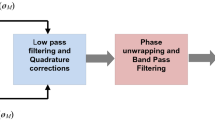Abstract
The paper evaluates the measurement uncertainty in realizing the secondary vibration standard at CSIR-National Physical Laboratory, India, and presents a comparison of the measurement uncertainty of secondary standard with that of primary vibration standard. The relative expanded measurement uncertainty of 0.80% to 2.2% in frequency range of 5 Hz to 10 kHz is evaluated. The measurement uncertainty so calculated is verified by comparison with the results from primary vibration calibration standard of CSIR-National Physical Laboratory, New Delhi, and SPEKTRA Schwingungstechnik und Akustik GmbH Dresden, Germany primary calibrations. The study recommends calibrating the back-to-back accelerometer with minimal uncertainty by using a primary calibrated single-ended accelerometer mounted on the top of the back-to-back transducer.The paper serves a guiding document to the calibration laboratories, industries and other stake holders in India to understand the concept of traceability in vibration measurements and formulation of uncertainty budget as per the international standard.








Similar content being viewed by others
References
N. Garg, O. Sharma and V. Mohanan, Current status of acoustic measurement standards at National Physical laboratory of India (NPLI), New Delhi, Part 2: acceleration amplitude, J Metrology Soc India, 22, (2007), 91–101.
N. Garg, K. Soni, A Kumar and T. K. Saxena, Applications of laser interferometry in providing traceable vibration measurements in India, MAPAN-J. Metrology Society of India, 30 (2) (2015), 91–104.
ISO 16063-11:1999, Methods for the calibration of vibration and shock transducers—part 11: primary vibration calibration by laser interferometry.
N. Garg, O. Sharma, A. Kumar and M. I. Schiefer, A novel approach for realization of primary vibration calibration standard by homodyne laser interferometer in frequency range of 0.1 Hz to 20 kHz, Measurement 45(2012), 1941–1950.
N. Garg, H. Kumar, A. Kumar and S. Maji, Application of laser interferometry in providing traceable vibration measurements, Proceedings of International Conference on Smart Technologies for Mechanical Engineering, 25th to 26th October, 2013, 253-258.
N. Garg and T. K. Saxena, Challenges ahead in vibration metrology: national and international perspectives, in Proceedings of 3rd National Conference on Advances in Metrology, Admet 2014, Thapar University, Patiala, India, pp. 222–223 (2014).
ISO 16063-21:2003, Vibration calibration by comparison to a reference transducer, International Electrotechnical Commission, Switzerland.
CS18 MF, Vibration calibration system, SPEKTRA Schwingungstechnik und Akustik GmbH Dresden, Germany, www.spektra-dresden.com
N. Garg and M. I. Schieffer Low frequency accelerometer calibration using an optical encoder sensor, Measurement, 111 (2017), 226–233.
N. Garg and Sharma O, Charge amplifier calibration in vibration metrology at NPL, India, Manufacturing Technology Today, 12 (2) (2013), 14–17.
JCGM 100:2008, Evaluation of measurement data-Guide to the expression of uncertainty in measurement.
B. F. Payne ,The application of back-to-back accelerometers to precision vibration measurements, Journal of Research of National Bureau of Standards, USA, 88 (3) (1983), 171–174.
Double vs single ended transfer standard reference, Technical library, http://www.modalshop.com.
NABL 164, National Accreditation Board for Testing and Calibration Laboratories, India, guidelines for inter-laboratory comparison for calibration laboratories where formal PT Programs are not available, Issue 03, April, 2016.
N. Garg, S. Yadav and D. K. Aswal, Monte Carlo Simulation in uncertainty evaluation: strategy, implications and future prospects, MAPAN-J. Metrology Society of India, 34(3) (2019), 299–304.
N. Garg, P. Surendran, M. P. Dhanya, A. T. Chandran, M. Asif and M. Singh, Measurement uncertainty in microphone free-field comparison calibrations, MAPAN-J. Metrology Society of India, 34(3) (2019), 357–369.
S. Yadav, A. Zafer, A. Kumar, N. D. Sharma and D. K. Aswal, Role of national pressure and vacuum metrology in Indian industrial growth and their global metrological equivalence, MAPAN-J. Metrol. Soc. India, 33(4) (2018) 347–359.
N. Garg, Establishing a traceability chain for sound pressure and vibration amplitude measurements, NCSLI Measure-The Journal of Measurement Science 10(1) (2015) 68–78.
Q. Sun and A. Liu, Final report on the key comparison APMP.AUV.V-K1.2, Metrologia 47 (2010), 09004
N. Garg, T. K. Saxena, M. I Schieffer, Bilateral comparison in primary vibration calibration of NPL, India and The Modal Shop, USA, Proceedings IMEKO Conference 22nd TC3, 12th TC5 and 3rd TC22, 3rd to 5th February, 2014, Cape Town, Republic of South Africa, (2014), pp. 24–27. http://www.imeko.org/publications/tc22-2014/IMEKO-TC22-2014-006.pdf
Key Comparison data base, BIPM, Paris, http://www.kcdb.org.
Acknowledgements
Authors are thankful to the Director, CSIR-National Physical Laboratory, India, Head, Physico-Mechanical Metrology Division and Head, Acoustics and Vibration Standards for providing the necessary infrastructural support under the networking projects, NWP-45; and CSIR-NPL Fund (Budgetary Head: OLP 120632, P-1225103 allocated in December, 2016) for the up-gradation of Secondary vibration calibration standard. Authors thank Mr. Philipp Begoff and Mr. Frank Schultz of M/s SPEKTRA, Schwingungstechnik und Akustik GmbH Dresden, Germany. Authors also thank Mr. Sandeep Rapeswal, M. Tech scholar, NIT Kurukshetra, for his help in FEM studies. One of the authors B S Chauhan is thankful to Deptt. of Science and Technology for DST INSPIRE fellowship for pursuing Doctorate at CSIR-National Physical Laboratory, New Delhi from AcSIR, Ghaziabad.
Author information
Authors and Affiliations
Corresponding author
Additional information
Publisher's Note
Springer Nature remains neutral with regard to jurisdictional claims in published maps and institutional affiliations.
Rights and permissions
About this article
Cite this article
Garg, N., Chauhan, B.S. Measurement Uncertainty in Vibration Calibration in Frequency Range of 5 Hz to 10 kHz. MAPAN 35, 397–405 (2020). https://doi.org/10.1007/s12647-020-00385-2
Received:
Accepted:
Published:
Issue Date:
DOI: https://doi.org/10.1007/s12647-020-00385-2




